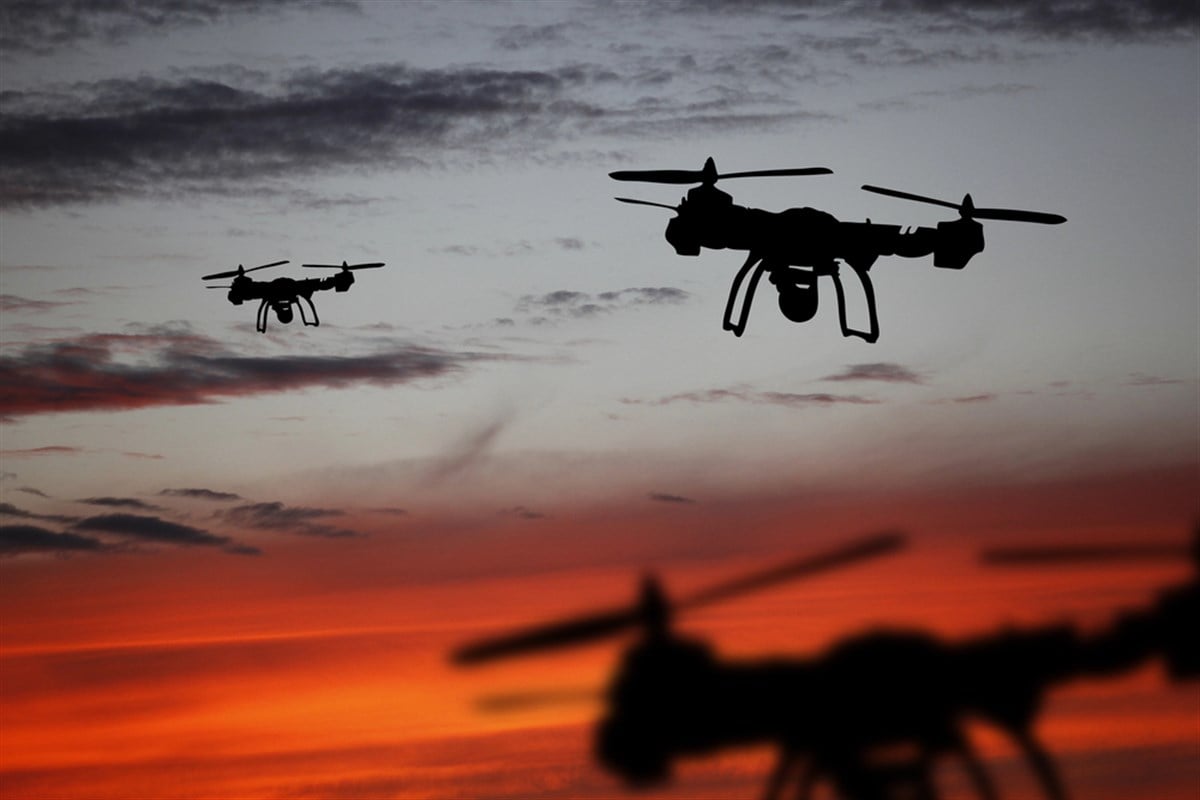 A new defense arms race is fueling a structural shift in the drone industry, creating long-term growth opportunities for key players in this... ͏ ͏ ͏ ͏ ͏ ͏ ͏ ͏ ͏ ͏ ͏ ͏ ͏ ͏ ͏ ͏ ͏ ͏ ͏ ͏ ͏ ͏ ͏ ͏ ͏ ͏ ͏ ͏ ͏ ͏ ͏ ͏ ͏ ͏ ͏ ͏ ͏ ͏ ͏ ͏ ͏ ͏ ͏ ͏ ͏ ͏ ͏ ͏ ͏ ͏ ͏ ͏ ͏ ͏ ͏ ͏ ͏ ͏ ͏ ͏ ͏ ͏ ͏ ͏ ͏ ͏ ͏ ͏ ͏ ͏ ͏ ͏ ͏ ͏ ͏ ͏ ͏ ͏ ͏ ͏ ͏ ͏ ͏ ͏ ͏ ͏ ͏ ͏ ͏ ͏ ͏ ͏ ͏ ͏ ͏ ͏ ͏ ͏ ͏ ͏ |
| | Written by Jeffrey Neal Johnson 
Explosive, triple-digit gains in the stock market often trigger warnings and fears of a speculative bubble. The recent performance of the drone sector (a subset of the aerospace sector), where companies have seen their valuations soar to angelic flight levels, is no exception. While caution is always prudent, investors looking deeper will find that the forces lifting these stocks are not based on hype or speculation. Instead, they are rooted in a permanent and accelerating structural shift in global military strategy and U.S. industrial policy. This new reality, more akin to a modern arms race in unmanned/crewless systems than a speculative frenzy, has created distinct opportunities for investors across the industry. From established leaders to high-tech innovators and critical supply chain enablers, the drone sector is capitalizing on a powerful, long-term trend. The most important question here is: Should you? Battlefield-Proven, Washington-Backed Two powerful and interconnected forces are driving the structural shift within the drone sector, providing a firm foundation for sustained industry growth through continued technological development. - The Geopolitical Imperative: Recent global conflicts have been a stark and undeniable proving ground for crewless and autonomous systems. Drones have demonstrated their immense value in intelligence, surveillance, and reconnaissance (ISR), while loitering munitions have redefined the modern battlefield with low-cost, high-precision strike capabilities. This battlefield validation has made crewless system platforms indispensable to U.S. and allied military doctrine, creating a non-negotiable, long-term demand cycle.
- The Policy Mandate: In response, Washington has pivoted decisively. Initiatives like the Pentagon's Unleashing American Drone Dominance strategy are designed to slash red tape, fast-track procurement, and, most critically, onshore the drone manufacturing supply chain. Significant budget allocations and a wave of contract awards back this policy shift. For investors, this government-backed demand is a powerful risk mitigator, ensuring corporate growth is driven by strategic necessity rather than market sentiment.
Leaders, Innovators, and Enablers This new landscape creates opportunities for various companies, each playing a distinct role. Examining these three key players reveals the different ways investors can gain exposure to this secular trend. AeroVironment: The Incumbent Leader Cashing In As the established industry leader, AeroVironment (NASDAQ: AVAV) is leveraging its scale and reputation to secure large, foundational defense programs. This financial strength is underpinned by a massive $1.1 billion funded backlog, which provides exceptional revenue visibility and helps justify its premium valuation. The $3.1 billion in unfunded backlog is even more telling, which points to a vast pipeline of future opportunities. The company’s recent performance underscores its dominant position, with record first-quarter 2026 revenue of $454.7 million, up 140% year over year. Furthermore, the successful integration of BlueHalo has significantly expanded AeroVironment’s technological moat into high-growth sectors like space and cyber. This expansion is already bearing fruit, evidenced by the recent $95.9 million U.S. Army contract for its Freedom Eagle (FE-1) counter-drone missile. For investors, these are clear signs that a company is successfully executing its strategy to capture next-generation programs. Kratos: The Innovator Building Tomorrow's Air Force Kratos (NASDAQ: KTOS) is the vanguard for next-generation warfare, focusing on high-performance tactical drones and hypersonic systems. Its stock performance is directly tied to its progress in developing the attritable aircraft central to the Pentagon's future strategy. The company’s powerful 1.2-to-1 book-to-bill ratio over the last twelve months indicates that demand is accelerating faster than current revenue recognition, a bullish signal for future growth. Reflecting this momentum, Kratos increased its full-year revenue guidance to $1.29-$1.31 billion. Long-term catalysts are also taking shape, with the company securing a prime position on the potential $750 million Poseidon program and forging a strategic partnership with Korea Aerospace Industries for Manned-Unmanned Teaming. These transformative wins provide a roadmap for future growth, underpinning the stock's strong performance and the Moderate Buy analyst consensus. Unusual Machines: The Key to a Secure Supply Chain As an emerging, pure-play specialist in NDAA-compliant drone components, Unusual Machines (NYSEAMERICAN: UMAC) is a direct beneficiary of the government’s onshoring mandate. Recent contract wins have served as a significant catalyst for the stock, providing tangible validation of its business model. For an emerging company, contracts like the U.S. Army order for 3,500 motors and the record $12.8 million order from prime contractor Strategic Logix are more than just revenue; they are powerful de-risking events that prove real demand exists. Bolstering this growth narrative is a strong balance sheet. With over $80 million in cash following recent financings and zero debt, Unusual Machines has the capital to rapidly scale production to meet the anticipated surge in follow-on orders. This financial strength supports the company’s high-growth trajectory and the Moderate Buy analyst consensus, which carries an average price target of $19.33, an upside of over 27%. An Industry in the First Inning The evidence strongly suggests that the drone sector is in the early stages of a secular, multi-year growth cycle driven by non-negotiable defense priorities. The powerful combination of battlefield necessity and deliberate government policy has created a durable tailwind for the industry. While market volatility is always a factor, the underlying fundamentals are robust. AeroVironment, Kratos, and Unusual Machines offer investors distinct ways to participate in this long-term growth story, from established leadership and high-tech innovation to the critical domestic supply chain. The data points not to a bubble, but to an industry whose moment has arrived.  Read This Story Online Read This Story Online |  Elon Musk just declared war on the wireless giants with a $17 billion spectrum deal that gives SpaceX the rights to deliver direct-to-cell service nationwide — a move tech analyst Jeff Brown says could shape the backbone of the coming space economy and create fortunes on a scale not seen since the rise of NVIDIA. Click here to watch Jeff's urgent briefing |
| Written by Nathan Reiff 
A company's comeback story can mean a significant opportunity for investors to win returns in the financial world. Of course, when a stock has shed a sizable portion of its value in recent memory, many investors prefer to exercise caution unless there is a clear signal that the firm's fortunes could turn around. If the anticipated rally does materialize, though, investors who purchased shares during the dip may see the largest gains. Wall Street analysts have predicted that the three companies below—The Trade Desk Inc. (NASDAQ: TTD), Summit Therapeutics PLC (NASDAQ: SMMT), and Sprouts Farmers Market Inc. (NASDAQ: SFM), each representing a unique industry and sector—could be poised for just such a comeback. Shares of all of these companies have been down in the last several months, but keen investors may find that they each present a compelling case for those with a fair degree of tolerance for risk. External Threats Impact The Trade Desk, But Platform Relaunch Could Boost Interest Ad tech giant The Trade Desk is down more than 54% year-to-date (YTD) as the company missed its EPS estimate for the latest quarter by 24 cents. The firm faces increasing competition from tech rivals, not primarily in advertising, including Amazon.com Inc. (NASDAQ: AMZN), which recently offered potential advertising customers free use of its demand-side platform (DSP) to test against its rivals' products. This directly threatens TTD after the firm lost its exclusive partnership with Walmart Inc. (NYSE: WMT) over the summer. But there are also reasons investors might be optimistic about The Trade Desk going forward. Despite slowing recently, the company's revenue growth of 19% year-over-year (YOY) for the latest quarter is still robust—TTD remains one of the very top ad tech firms, despite the rise of rivals. Some of the revenue slowdown is due to user pushback on its Kokai platform, but the firm announced a broad range of enhancements in September that could help to renew interest. One feature in particular, Deal Desk—launched earlier in the year—fills an important gap as a deal optimization and pacing tool. Analysts are somewhat mixed on TTD shares, but a majority (21 out of 37) call the stock a Buy. TTD has a consensus price target of more than $84, nearly 58% above where it currently trades. Summit's Pipeline Is Promising, But Cash Position Is a Risk Clinical-stage biotech firm Summit Therapeutics is known for a major candidate, ridinilazole, for the treatment of Clostridioides difficile infections. The company is not yet profitable and indeed posted wider-than-expected losses per share in its third quarter of 2025. Summit's biggest hurdle may be its cash runway: it ended the latest quarter with under $239 million in cash, as well as rising operating expenses that are eating away at reserves quickly. Summit executives have suggested a potential equity financing or at-the-market event that could help to finance its latest trials. However, this would dilute current shareholders, who have responded by sending SMMT shares downward by close to 20% in the last six months. Still, the company has a promising pipeline if Summit can address its cash flow issues. Summit plans to submit a biologics license application related to Ivonescimab, a potential treatment for certain types of lung cancer, this quarter. The drug candidate's phase III trial is set to expand, a positive sign for potential marketability later on. Twelve out of 18 analysts see SMMT shares as a Buy, and the company has upside potential of nearly 60% based on a consensus price target of $31.14. Strong Fundamentals Could Help Sprouts to Trend Higher Organic specialty grocer Sprouts Farmers Market has seen shares fall by almost 20% this year amid inflation and consumer sentiment concerns. However, the company's latest earnings are promising—it notched both top and bottom-line beats as sales grew by 17% YOY, led by strong e-commerce sales growth. Management raised sales and other forecasts for the full year at that time. The company has also provided incentives to shareholders by putting its operating cash flow of more than $400 million as of mid-year to use, including through $292 million of share repurchases. Sprouts' focus on wealthy customers and regions may help to insulate it from rising grocery prices and tariff concerns. Analysts seem to think so, as 10 out of 15 see SFM stock as a Buy, with about 51% in upside potential.  Read This Story Online Read This Story Online |  Have you heard of this $1 'magic' AI stock? They are building what some people are calling 'ChatGPT with eyes'.
And it might be as revolutionary as the introduction of the iPhone was. But very few people have actually heard of this stock.
And there's a weird, little-known way investors can get in for less than $1 / share. But hurry... the last chance to invest at their current valuation is October 30.  Secure your shares before Thursday >> Secure your shares before Thursday >> |
| Written by Jeffrey Neal Johnson 
The moments after an earnings release often tell a story, and for Intel Corporation (NASDAQ: INTC), the story on Oct. 23 and since then has been one of resounding validation. A powerful upward momentum in the stock followed Intel’s third-quarter report, sending shares to multi-year highs above $40 and pushing its year-to-date gain to nearly 100%. This is the market’s decisive, favorable verdict on a landmark quarter, leaving investors wiping away the stress sweat after a long-fought recovery. The report delivered a powerful beat on every key metric and provided a robust outlook, signaling that Intel's ambitious and costly turnaround is working and accelerating. For investors, this was the moment the narrative shifted from a plan on paper to a reality backed by hard numbers, providing the first undeniable financial proof that the company's strategy is succeeding far ahead of schedule. Shattering Expectations: The Numbers Behind the Rally Intel's third-quarter financial results were the clear catalyst for the stock's re-rating, with the company outperforming on every key measure. The performance was so strong that it surpassed not only the original consensus from Intel’s analyst community but also the company’s own optimistic pre-announcement from earlier in the month. For investors, the numbers tell a clear story of a company rapidly regaining its financial footing. - Strong Revenue Beat: The company reported Q3 revenue of $13.7 billion, up 3% year over year. This figure topped analyst consensus estimates of approximately $13.1 billion, demonstrating solid underlying demand.
- Profitability Surge: Intel delivered a non-GAAP earnings per share (EPS) of 23 cents, crushing the breakeven consensus. The company also returned to GAAP profitability, posting a net income of $4.1 billion, or 90 cents per share, a reversal from the losses of prior quarters.
- The Margin Masterstroke: Perhaps the most critical metric for the long-term health of the business, non-GAAP gross margin came in at 40.0%. This beat the 36.0% guidance and represented a 22-percentage-point year-over-year improvement. It is the clearest signal yet that Intel is regaining manufacturing efficiency and pricing power far faster than anyone anticipated.
- Confident Outlook: The company provided a robust Q4 forecast, including a revenue range of $12.8 billion to $13.8 billion and a non-GAAP EPS of 8 cents, signaling management's confidence that the positive momentum is sustainable.
AI PCs and a Stabilizing Data Center The financial beat was not an accounting anomaly; it was driven by tangible success in Intel's core business segments. Management commentary on the earnings call detailed the two main engines that powered the outperformance. The first was the impressive strength in the Client Computing Group (CCG), which grew 5% year-over-year to $8.5 billion and generated an impressive $2.7 billion operating income. This growth was attributed directly to what leadership now describes as the beginning of an artificial intelligence (AI) PC super cycle. Stronger-than-anticipated demand for new laptops powered by Intel's Core Ultra processors confirms that the company's early lead in this emerging category successfully translates into high-margin sales. The second key driver was the better-than-expected performance of the Data Center and AI (DCAI) segment. While its revenue was down slightly, the segment delivered a solid $4.1 billion in revenue and $1 billion in operating income. This is a crucial sign of stabilization in a business that had previously been a source of weakness. Adding to the positive sentiment, management noted that overall demand exceeds supply. This is a high-quality problem for investors, as it indicates strong desirability for Intel's products across the board. The $20 Billion War Chest Underpinning the quarter's operational success is a story of dramatic financial fortification. As highlighted in the earnings report, Intel executed a series of major strategic deals in the third quarter that have fundamentally transformed its balance sheet. The company secured commitments for roughly $20 billion in cash from a combination of sources. The money received in the quarter included $5.7 billion in funding from the U.S. government, $2.0 billion from SoftBank Group, and a combined $5.2 billion from the completed Altera transaction and a Mobileye stake sale, with an expected $5.0 billion from NVIDIA's (NASDAQ: NVDA) investment, which is expected to close in the fourth quarter. This massive capital infusion provides a powerful backstop for the company's ambitious turnaround strategy. At the end of the quarter, the company's cash and short-term investment position reached a formidable $30.9 billion. Management immediately put some of this capital to work, repaying $4.3 billion of debt. For investors, this fortified balance sheet is a critical component of the de-risking story, providing immense flexibility to fund manufacturing expansion and R&D with confidence. Don’t Call It a Come Back, It’s a Turnaround This quarter was the moment the Intel turnaround story shifted from a plan on a slide deck to a reality backed by hard numbers. The company's ability not only to meet but to shatter expectations has forced a profound re-evaluation on Wall Street. The days following the report saw a wave of significant analyst price target upgrades from previously skeptical firms, with new targets from major banks like Wells Fargo ($45) and Benchmark (to a street-high $50) signaling a significant shift in institutional sentiment. The stock has surged past the average analyst price target, a classic sign that the market is re-rating the company's prospects faster than the consensus can adjust. The investment narrative has now fundamentally shifted. For the past year, it has been a speculative show-me story. With a powerful financial beat now delivered, it has become a credible believe-it story. For investors, the question is no longer if the turnaround will work but how fast it will accelerate from here.  Read This Story Online Read This Story Online |  Have you heard about this sub $1 company that is making people "Superhumans"?
Investors are calling this a 'massive breakthrough'.
But not for the reason you think...
Investors already having started flooding in to take advantage of this while the company is still private.
But this opportunity won't be around forever... They've officially reserved a Nasdaq ticker and the last chance to invest at current valuation is October 30th. Round Closes in 48 Hours – Secure Your Shares Today! |
| More Stories |
| |
|
|